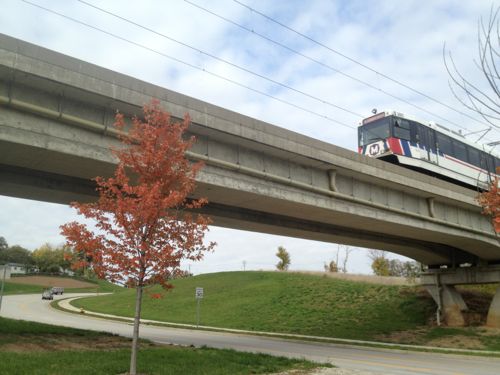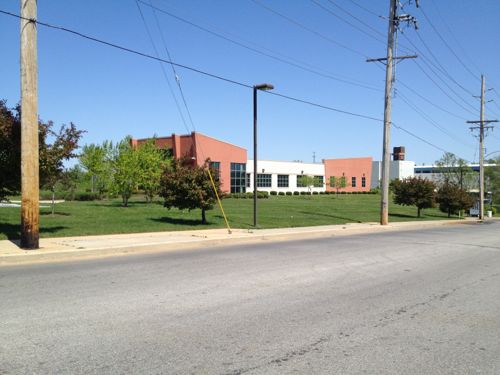Lack of Land-Use Controls Among Reasons Why So Little Transit-Oriented Development At MetroLink Stations After Two Decades
Today is the 20th anniversary of the opening of our original MetroLink light rail line. Since then we’ve added a line in Illinois and one in St. Louis County.

One thing we haven’t really seen much of is transit-oriernted development (TOD). We’ve had a few projects that are, at best, transit-adjacent development (TAD).
TAD is TOD gone bad, development that is adjacent to transit but breaks all the rules that make TOD work, like making public spaces the focus of building orientation and neighborhood activity; creating pedestrian-friendly street networks that directly connect local destinations; and providing a mix of housing types, densities and costs. (TOD’s Evil Twin: Transit-Adjacent Development)
In the poll last week I asked about the lack of TOD in the last two decades:
Q: Why do you think our MetroLink light rail stations haven’t seen much transit-oriented development in the last 20 years? (Pick up to 3)
- Lack of proper land-use controls, like form-based zoning 42 [13.21%]
- Nobody pushed for TOD 37 [11.64%]
- Regional fragmentation of leadership 37 [11.64%]
- Regional job & population growth have been stagnant 37 [11.64%]
- The station designs aren’t conducive for infill development 31 [9.75%]
- Located in bad locations. 29 [9.12%]
- The alignment isn’t convenient to many 27 [8.49%]
- No demand for transit-oriented development 23 [7.23%]
- We naively thought if we built it they’d come 17 [5.35%]
- Used mainly for games, events, to reach Lambert airport 15 [4.72%]
- Another reason not listed 10 [3.14%]
- Our laissez-faire love of the free market 8 [2.52%]
- Naysayers muted initial enthusiasm, halting TOD potential 4 [1.26%]
- Park & ride lots are the best use of the land at the stations 1 [0.31%]
- Unsure/no answer 0 [0%]
All of the above (except #14) are valid reasons, I think they ended up in about the right order too. A form-based code at the Wellston station would’ve required St. Louis County Economic Council building to acknowledge the presence of light rail.

When the county government doesn’t do set a good example, how can we expect others to do better on their own?
In the last couple of years there has been a TOD push. Better late than never or too little, too late?
— Steve Patterson
Zoning / Land Use Controls GUIDE development, they don’t make it HAPPEN! Development – good or bad, TOD or sprawl, dense or barren – happens because there are consumers for whatever is being developed. For TOD to succeed here, we need to make all transit – buses included – much more attractive to people who don’t use it/them now. If all you can expect from doing TOD is a tiny increase in interest / return on investment (or worse, a negative reaction), guess what? Most developers are going to stick with “what works”, land use controls be damned! Name one jurisdiction in the region that won’t change zoning or throw TIF money at a developer who promises more sales taxes! We get TAD not because our land use controls are weak, we get TAD, if that, because people here choose (or are forced) to drive way more than they choose (or are forced) to use public transit!
I think land use controls and zoning is a very slippery slope. Suppose I’ve owned land along a route for 20 years, where does one local government get off telling me what I can and cannot put on my property? Yeah, I know all about zoning laws and how they can change but that isn’t the point. Local control is made up of too many little groups of power hungry people..or people that think they know better. If buy land for, let’s say a house, I expect it to stay that way. (just pointing out a possible view point, save your rants).
This leads to my second point…too many local groups, governments included, to decide. They spend so much time doing everything BUT building good transit for the good of the area. Which leads to my third point…the alignment is not convenient. Of course it’s not convenient….because either someone doesn’t want to be upset (see above), someone has more clout than another, someone doesn’t want “those people” on their shiny new toys, and worse….they aim new construction at current ridership areas, not on increasing areas where there is no ridership.
See Village of Euclid, Ohio v. Ambler Realty Co from 1926: http://en.wikipedia.org/wiki/Village_of_Euclid,_Ohio_v._Ambler_Realty_Co.
An interesting case but maybe not relevant. Ambler was vacant farm land and the City wanted to put zoning codes in effect. My point is this; let’s say you bought a house for living…however it’s been zoned before doesn’t really matter as it’s zoned for such now. But now a developer wants to come in and buy your house for a strip mall next to the new metro station they’re going to put in down the block. You’re stubborn and you want to stay. No strip malls. You hate them. You have to fight them and risk maybe losing.
But why should you have to fight to protect what you have? What if you don’t have a good attorney or can’t afford one?
Don’t get me wrong….zoning and use controls can be very helpful. Hell, they even helped us deny a junk yard that wanted to come in our residential neighborhood. But it can be a very slippery slope of who get’s to decide what’s the best use for that property. I mean, just look at the airport and how many neighborhoods were re-zoned and destroyed for a near-worthless runway. It’s that WHO that is very, very dangerous to me.
On to other things….SLU is getting retail. I saw the interview where the developer was mentioning putting the parking lot in the read of the building. I wonder how many entrances will be along Forest Park Blvd, if any.
Not relavent? This was the Supreme Court case that made zoning legal 87 years ago. Yes, it was a slippery slope. City after city adopted the concept of single use zoning for land after this ruling, making the owner’s apartment over the mom & pop store no longer an option. For decades government has been telling property owners what they can and can’t do since before my parents were born.
No land owner should complain about being allowed to develop their land even more intensely. Reduced parking requirements also has a higher economic return for the land owner. Nothing burdens the inner-city landowner more than suburban setbacks and parking requirements that render older buildings and smaller lots non-conforming.
A trick to combat legal challenges would be a form-based overlay that grandfathers all existing buildings and uses. Then, every owner has the free-market choice of retaining existing uses that require little to no development review, seeking an adaptive reuse of the building with flexible standards, or going for complete redevelopment that meets standards for pedestrian-scaled design.
I get that form based zoning is better, in many ways, than traditional, Euclidean zoning. My point is that development, especially denser development, only happens when there is a demand for higher densities. Much of the city already allows much higher densities than what is currently in place or is currently being constructed, even with the “old” zoning, and I’m not aware of any project being turned down because it’s too dense, especially around any of our Metrolink stops. We get the suburban-scale stuff (crap?) because it’s a) cheap to build, b) our land is cheap, c) developers are comfortable with it, and d) parking is what most people want! Many (most?) businesses (and many residential uses) see dedicated parking as a positive, unlike public transit, and just reducing what the government requires doesn’t mean that less will actually be constructed. And no, creating a “floor”, as well as a “ceiling”, for both parking and GFA, will NOT be the magic elixir! If the numbers don’t work, the project won’t be built, period – see BPV for one big example! The best path is to focus on both accommodating and hiding the parking, not wishing and hoping that it will simply “go away” . . . .
I disagree, I believe a shared community vision codified in form-based zoning can generate interest where none existed before.
Generating interest and closing the deal are two very different things. I’ve seen many community-based visions pushed aside in the chase for the almighty dollar. Not saying don’t do it, just keep it real.
your link isn’t working . . . .
The alignment for the original metrolink line was chosen because the right of way
became available and because the line served many major employment destinations
The line basically relied on transfers from eisting bus routes and worked to greatly
decrease the time to get places such as downtown and barnes on public transit.
The alignment for the second route was chosen to connect the system to Clayton
and to be the most expensive part (because of getting from Debal to Clayton) of
what would be subsequent legs to s county and to westport. The idea of stimu-
lating development was not really part of the decision-making, and that idea is
more of an economic development/urban form issue than a transit issue